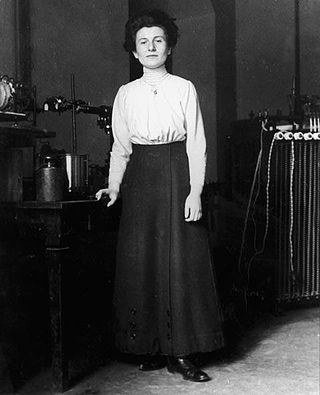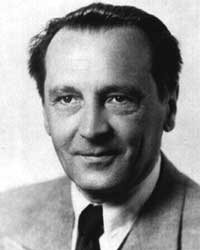Related Research Articles

The Auger effect or Auger−Meitner effect is a physical phenomenon in which the filling of an inner-shell vacancy of an atom is accompanied by the emission of an electron from the same atom. When a core electron is removed, leaving a vacancy, an electron from a higher energy level may fall into the vacancy, resulting in a release of energy. For light atoms (Z<12), this energy is most often transferred to a valence electron which is subsequently ejected from the atom. This second ejected electron is called an Auger electron. For heavier atomic nuclei, the release of the energy in the form of an emitted photon becomes gradually more probable.

Lise Meitner was an Austrian-Swedish physicist who was instrumental in the discoveries of nuclear fission and protactinium.

Otto Hahn was a German chemist who was a pioneer in the fields of radioactivity and radiochemistry. He is referred to as the father of nuclear chemistry and father of nuclear fission, the science behind for nuclear reactors and nuclear weapons. Hahn and Lise Meitner discovered isotopes of the radioactive elements radium, thorium, protactinium and uranium. He also discovered the phenomena of atomic recoil and nuclear isomerism, and pioneered rubidium–strontium dating. In 1938, Hahn, Meitner and Fritz Strassmann discovered nuclear fission, for which Hahn alone was awarded the 1944 Nobel Prize for Chemistry.

Ludwig Eduard Boltzmann was an Austrian physicist and philosopher. His greatest achievements were the development of statistical mechanics, and the statistical explanation of the second law of thermodynamics. In 1877 he provided the current definition of entropy, , where Ω is the number of microstates whose energy equals the system's energy, interpreted as a measure of the statistical disorder of a system. Max Planck named the constant kB the Boltzmann constant.

Otto Robert Frisch was an Austrian-born British physicist who worked on nuclear physics. With Otto Stern and Immanuel Estermann he first measured the magnetic moment of the proton. With Lise Meitner he advanced the first theoretical explanation of nuclear fission and first experimentally detected the fission by-products. Later, with his collaborator Rudolf Peierls he designed the first theoretical mechanism for the detonation of an atomic bomb in 1940.

Franz Serafin Exner was an Austrian physicist and professor at the University of Vienna. He is known for pioneering physical chemistry education in Austria. The early introduction to university curricula of subjects such as radioactivity, spectroscopy, electrochemistry electricity in the atmosphere, and color theory in Austria are often credited to him.

Hedwig Kohn was a physicist who was one of only three women to obtain habilitation in physics in Germany before World War II. Born in Breslau in the German Empire, she was forced to leave Germany during the Nazi regime because she was Jewish. She continued her academic career in the United States, where she settled for the rest of her life.

Egon Schweidler, was an Austrian physicist.

Josef Mattauch was a nuclear physicist and chemist. He was known for the development of the Mattauch-Herzog double-focusing mass spectrometer, for his work on the investigation of isotopic abundances using mass spectrometry, and the determination of atomic weights. Much of his career was spent at the Kaiser Wilhelm Institute for Chemistry.
Berta Karlik was an Austrian physicist. She worked for the University of Vienna, eventually becoming the first female professor at the institution. While working with Ernst Foyn she published a paper on the radioactivity of seawater. She discovered that the chemical element 85 astatine is a product of the natural decay processes. The element was first synthesized in 1940 by Dale R. Corson, K. R. MacKenzie, and Emilio Segrè, after several scientists in vain searched for it in radioactive minerals.
Stefan Meyer was an Austrian physicist involved in research on radioactivity. He became director of the Institute for Radium Research in Vienna and received the Lieben Prize in 1913 for his research on radium. He was the brother of Hans Leopold Meyer who was also awarded the Lieben Prize.
Isolde Hausser was a German physicist. She became the head of a department of the Max Planck Institute for Medical Research in Heidelberg in 1935.

Heinrich Mache was an Austrian physicist. He won the Haitinger Prize of the Austrian Academy of Sciences in 1915.
Monika Ritsch-Marte is an Austrian physicist in the fields of biomedical optics, theoretical quantum optics and non-linear optics. She is a professor at the Medical University of Innsbruck and director of the Institute of Biomedical Physics.
Frances Gertrude Wick was an American physicist known for her studies on luminescence.

Johanna Barbara Stachel is a German nuclear physicist. She is a professor in experimental physics at the University of Heidelberg. Stachel is a former president of the German Physical Society (DPG).
Vera V. Fischer is a mathematician specializing in set theory, mathematical logic, and infinitary combinatorics. She is a privatdozent in the Kurt Gödel Research Center for Mathematical Logic at the University of Vienna.
The Lise Meitner Lectures (LML) are a series of public lectures in honour of Lise Meitner. The lectures are organized jointly by the German Physical Society and the Austrian Physical Society, with the intention to showcase outstanding female scientists in physics or related fields. The annual lecture series was launched in 2008, when Lise Meitner's birthday celebrated its 130th anniversary. In October 2008, the Lise Meitner Lecture was held in Vienna and Berlin with an accompanying exhibition. The annual lecture series not only aims at increasing the visibility of successful female researchers, but also at encouraging girls and young women towards careers in physics.

Olga Ehrenhaft-Steindler was an Austrian physicist and science teacher. In 1903, she became the first woman to earn a physics doctorate at the University of Vienna. She established the first Wiener Handelsakademie für Mädchen, as well as a grammar school for girls, in 1907.
References
- 1 2 3 Krafft, Fritz (1 November 1978). "Lise Meitner: Her Life and Times—On the Centenary of the Great Scientist's Birth". Angewandte Chemie International Edition in English. 17 (11): 826–842. doi:10.1002/anie.197808261. ISSN 1521-3773.
- 1 2 3 Angetter, Daniela; Martischnig, Michael (2005). Biografien österreichischer [Physiker]innen. Eine Auswahl. Vienna: Österreichisches Staatsarkiv (Austrian State Archives). p. 36.
- ↑ "Rigorosenakt". Archiv der Universität Wien. 1968.
- 1 2 "Selma Freud". "Lise"--part of the Projekt IMST3 of the Austrian initiative FFORTE – Frauen in Forschung und Technologie (Women in Research and Technology). Retrieved 4 June 2019.
- ↑ Przibram, Karl (1959). "Erinnerungen an ein altes physikalisches Institut". In Frisch, O.R. (ed.). Beiträge zur Physik und Chemie des 20. Jahrhunderts[Recollections on an Old Physics Institute] (in German). Springer Fachmedien Wiesbaden. p. 3. doi:10.1007/978-3-663-20204-2_1. ISBN 978-3-663-19866-6.
- ↑ "The Salvation Army International - Switzerland, Austria and Hungary". www.salvationarmy.org. Retrieved 4 June 2019.
- ↑ Freud, Selma (November 1937). "Reisebericht" [Trip Report]. Der Kriegsanruf. 64.